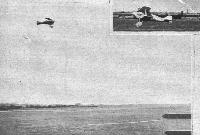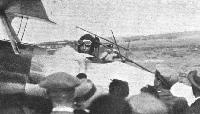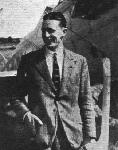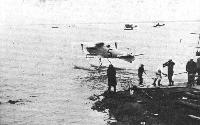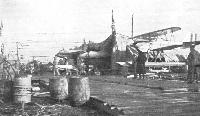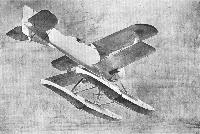
Варианты
- Gloster - I - III - 1923 - Великобритания
- Gloster - IV - 1926 - Великобритания
- Gloster - VI Golden Arrow - 1929 - Великобритания
Gloster I/II
В начале 1923 года самолет Mars I был оснащен более мощным двигателем Lion и получил значительно модернизированное крыло, баки с топливом и водой из которого были перенесены в фюзеляж, что позволило ликвидировать так ухудшавший обзор кабан. Столь существенные доработки заставили изменить название самолета на Gloster I. После победы в авиационных гонках 1923 года машина была куплена Королевскими ВВС и оснащенная поплавковым шасси использовалась в Феликстоу для тренировок в Звене скоростных полетов ВВС.
Способность фирмы "Gloster" строить самолеты с высокими характеристиками позволила ей получить заказ от Министерства авиации на два аэроплана Gloster II, которым предстояло принять участие в гонках на кубок Шнейдера в 1924 году. Отличавшийся от Gloster I большим выносом крыла, Gloster II был оснащен двигателем Napier Lion VA мощностью 585 л. с. (436 кВт) и металлическим винтом Fairey Reed. Поплавки обтекаемой формы и различные зализы значительно улучшили аэродинамику машины. Первый самолет (J7504) был передан для испытаний в Феликстоу 12 сентября 1924. Неделю спустя, когда самолет пилотировал Хьюберт Брод, при посадке на волны подломилась передняя стойка поплавка. Самолет практически мгновенно затонул, но, к счастью, Броду удалось спастись. Вскоре после этого гонку Шнейдера 1924 года отменили, и второй Gloster II был достроен с колесным шасси. Он использовался для скоростных испытаний и был разбит при посадке в середине 1925 года.
ТАКТИКО-ТЕХНИЧЕСКИЕ ХАРАКТЕРИСТИКИ
Gloster I (с колесным шасси)
Тип: одноместный гоночный биплан
Силовая установка: один 12-цилиндровый двигатель Napier Lion мощностью 530 л. с. (395 кВт)
Летные характеристики: максимальная скорость у земли 354 км/ч; время набора высоты 3048 м - 4 мин 18 с
Масса: пустого 894 кг; максимальная взлетная 1202 кг
Размеры: размах крыла 6,09 м; длина 7,01 м; высота 2,84 м; площадь крыла 15,31 мг
Описание:
- Gloster I/II
- Gloster III
- Flight, September 1925
THE SCHNEIDER CUP SEAPLANE RACE
Фотографии
-
Flight 1923-08 / Flight
THE GLOUCESTERSHIRE AIRCRAFT COMPANY'S NEW RACER: The "Gloster," with Napier "Lion," is a "cleaned-up" version of the famous "Bamel," and it will be noticed that, as regards external appearance, the main alteration is formed by the disappearance of the petrol tank from the cabane.
-
Aeroplane Monthly 1989-06 / K.Wixey - Folland's racers (1)
Регистрационный номер: G-EAXZ [6], J7234 [6] The Gloster Bamel photographed at the last Aerial Derby, staged at Croydon on August 6, 1923.
-
Flight 1924-05 / Flight
Регистрационный номер: G-EAXZ [6], J7234 [6] THE "GLOSTER": A side view of the Gloucestershire Aircraft Company's world's record speed machine "Gloster," which won the Aerial Derby last Monday. A front view of this, aeroplane appeared last week exclusively in "Flight." The engine is a 450 h.p. Napier "Lion."
The Gloucestershire ''Gloster" won the 1923 Aerial Derby at a speed of slightly less than 200 m.p.h. -
Flight 1923-08 / Flight
THE AERIAL DERBY, 1923: The winner, Mr. L. L. Carter, finishing on the "Gloster" (450 Napier "Lion") at a mean speed of 192-4 m.p.h. Inset, on the right, the "Gloster" is seen starting.
-
Flight 1923-08 / Flight
Mr. L. L. Carter, the pilot of the Aerial Derby winning "Gloster," immediately after "coming to earth." Both he and his machine, as may be noticed, were smothered with oil from a leaking oil pipe.
-
Flight 1923-08 / Flight
THE AERIAL DERBY: Mr. L. L. Carter, the pilot of the 200 m.p.h. "Gloster," after the race
-
Aeroplane Monthly 1989-06 / K.Wixey - Folland's racers (1)
Регистрационный номер: J7234 [6], G-EAXZ [6] Another view of the Gloster I racing seaplane, J7234. After serving as a trainer with the High Speed Flight it was scrapped in April 1930.
-
Aeroplane Monthly 1989-07 / K.Wixey - Folland's racers (2)
Регистрационный номер: J7234 [6], G-EAXZ [6] Originally known as the Mars I and registered G-EAXZ, the Gloster I was later purchased by the Air Ministry and put on floats. It was used by the RAF High Speed Flight in training pilots to gain experience for competing in the 1925-1927 Schneider contests.
-
Aeroplane Monthly 1989-06 / K.Wixey - Folland's racers (1)
Регистрационный номер: J7234 [6], G-EAXZ [6] The Mars I/Bamel after modification and redesignation as the Gloster I, fitted with floats and serving the RAF as J7234.
-
Aeroplane Monthly 1989-07 / K.Wixey - Folland's racers (2)
Регистрационный номер: J7234 [6], G-EAXZ [6] The Gloster I J7234 at Felixstowe in 1924. The dark areas on the wings are surface radiators. Fitted above the top wing is a coolant header tank, and J7234 is also fitted with the revised tail unit.
-
Aeroplane Monthly 1989-07 / K.Wixey - Folland's racers (2)
Регистрационный номер: J7504 [2] J7504 was the first of two Gloster IIs built to a 1924 Air Ministry order at a total cost of around £6,000. Designed for the 1924 Schneider contest, J7504 sank during trials before the race. Test pilot Hubert Broad managed to escape.
-
Flight 1925-06 / Flight
Регистрационный номер: J7504 [2] Типичный гоночный гидросамолет своего времени, Gloster II представлял собой попытку разместить двигатель максимальной мощности в планере минимальных размеров. Другими характеристиками, например, хорошей управляемостью, приходилось жертвовать.
The Gloster II Seaplane: It was on a sister 'plane fitted with wheels that Larry Carter met with a mishap while flying at Cranwell. The engine is a Napier "Lion." Note the careful streamlining and the Lamblin strut radiators.
-
Flight 1925-10 / Flight
THE SCHNEIDER CUP RACE: This official photograph of the Gloster-Napier III gives a very good idea of the general design. Noteworthy features are the very careful streamlining and the small size of the machine in relation to its floats.
-
Flight 1925-10 / Flight
THE BRITISH SCHNEIDER CUP CHALLENGERS: This front view give an excellent idea of the manner in which head resistance has been cut down to a minimum.
-
Aeroplane Monthly 1989-07 / K.Wixey - Folland's racers (2)
Регистрационный номер: N194 [5] View of the Gloster III N194, the Gloucestershire Aircraft company's most successful racing seaplane. Two were built to compete in the 1925 schneider contest. Powered by a 700 h.p. 12-cylinder Napier Lion VII, the 20ft span biplane was completed in 1925. Trials were successfully carried out at Felixstowe in August in time for the two aircraft to be shipped out to Baltimore in early October.
-
Flight 1925-10 / Flight
Регистрационный номер: N194 [5] THE SCHNEIDER CUP RACE: This side view of the British challenger, the Gloster-Napier III
-
Aeroplane Monthly 1989-07 / K.Wixey - Folland's racers (2)
Регистрационный номер: N195 [2] N195, the second Gloster III, was first flown on June 3, 1925 by Bert Hinkler. It was flown only once before being shipped to the USA for the 1925 contest, held at Baltimore.
-
Мировая Авиация 140
Регистрационный номер: N194 [5] Gloster IIIA N194 в Феликстоу после модификации хвостового оперения. Этот самолет занял второе место в гонках на кубок Шнейдера в 1925 году.
-
Aeroplane Monthly 1989-07 / K.Wixey - Folland's racers (2)
Регистрационный номер: N194 [5] Gloster III N194 pictured at Felixstowe following modification to the tail unit, after which it was given the designation IIIA. Although it was designed to feature wing surface radiators, insufficient time necessitated the fitting of the large ugly Lamblin units on the leading edges of the lower wings, as seen here. N194 made its first flight on August 29, 1925; Hubert Broad was the pilot.
-
Aeroplane Monthly 1989-07 / K.Wixey - Folland's racers (2)
Регистрационный номер: N194 [5] Following its success at the 1925 Schneider contest, N194 was given a curved leading edge to its fin.
-
Flight 1925-11 / Flight
THE SCHNEIDER CUP RACE: Capt. Broad's Gloster-Napier III leaving the slipway or its first test flight. In the background may be seen the Supermarine-Napier S.4, and, on the right, some of the American seaplanes which were to take part in the demonstration planned for Schneider Cup day.
Другие самолёты на фотографии: Supermarine S.4 - Великобритания - 1925
-
Flight 1925-09 / Flight
THE SCHNEIDER CUP RACE: These three views of the Gloster-Napier III give a reasonably good idea of the clean lines of Mr. Folland's design. The special Napier racing engine is totally cowled-in, and streamlining generally has been carried out to the greatest possible extent. At the top is a view of the machine taking off.
-
Flight 1925-11 / Flight
THE SCHNEIDER CUP RACE: Broad cornering on the Gloster-Napier III over the pier at Bay Shore Park.
-
Flight 1925-11 / Flight
ON THE SLIPWAY AT BAY SHORE PARK: In the foreground is a U.S. Navy "dog ship," and farther back the Supermarine-Napier S.4, while in the background may be seen the Gloster-Napier III.
Другие самолёты на фотографии: Curtiss F6C / P-1 / Hawk / Model 34 - США - 1925Supermarine S.4 - Великобритания - 1925
-
Flight 1925-11 / Flight
THE 1925 SCHNEIDER TROPHY RACE: An impression of Captain Broad's Gloster-Napier III racer, which secured second place in the race.
-
Flight 1926-12 / Flight
Регистрационный номер: N195 [2] Gloster III. racing seaplane with Napier Lion engine.
- Фотографии



